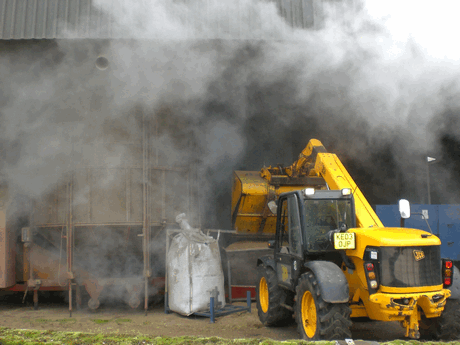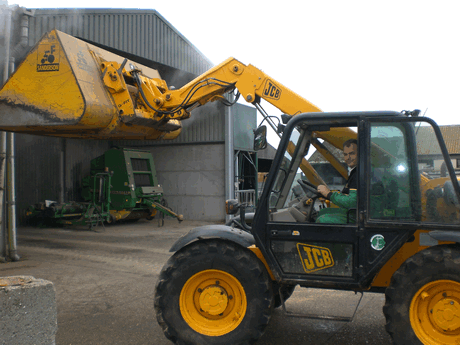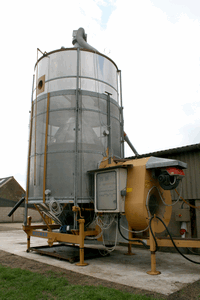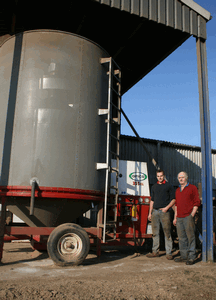Could a mobile grain drier be the best way to boost your drying capacity next harvest?

If there is one piece of equipment that proved its worth this year, it was the humble mobile grain drier. Whether it was used as a stopgap or relied upon as the primary drier, many growers wouldn’t have been able to cope without it.
With the latest mobile driers getting bigger and more automated, there are now models that range in throughput from 9t capacity up to a massive 55t. They can be used as simple manual batch driers run from a tractor pto or can be part of a more automated system.
The three biggest-selling makes in the UK are US-made GT gas and Italian-made diesel-fired driers sold by Opico, Italian MecMar machines sold by MecMar UK and Italian-made Pedrotti units sold by Master Farm Services.
Opico
Although mobile driers have traditionally been pto-driven, the drive to cut labour means three-phase electric options have become increasingly popular, says James Woolway of Opico. All the company’s automatic models have electric motors with horizontal discharge augers which can be positioned at any angle.
The most popular units are its gas fired 600QF and 800QF automatic driers, which have a high resale value, he says. “From the original models, a huge number of options have evolved to suit different situations. These include a centrifugal fan rather than an axial one to reduce noise, twin discharge augers instead of single and any number of automated alternatives.”
Prices range from £23,578 for a basic 9t holding capacity drier to £53,885 for a fully automatic 20t unit.
MecMar
The general trend for those buying mobile driers is to go bigger, says Stewart McArthur of MecMar UK.
“The 18t, 25t and 35t capacity units are the most popular models at the moment and overall sales are up about 30% this year.”
There are three basic options for the MecMar unit – tractor pto driven, electric with auto-empty, and totally automatic. “The latter makes the machine an installed unit, rather than a mobile one,” he adds.
Most machines now tend to be installed or semi-installed, but they are still essentially mobile and easy to sell on.
Prices range from £25,000 for a 10t capacity pto-driven unit to £54,000 for 40t electric-driven one.
Master Driers
The increasing demand for larger machines also holds true for Master Driers, says the company’s Bill Ingram. Although the firm still produces the smaller 6t, 7t and 8t capacity models, 40% of models sold are now 25t capacity. In the past 18 months, more farmers have been opting for the 38t model, with eight sold this year.
Mr Ingram believes 45t machines will probably represent the size limit at which farmers would start to think seriously about a continuous-flow static drier.
“This harvest we have had a lot of enquiries about upgrading, from 15t to 25t, for example,” he says.
Case study 1

Gary Speirs, Pepsal End Farm, Bedfordshire
Arable cropping: 780ha
Drier: Master Driers XLM 380
Capacity: 38t
Power Required: 120hp (pto)
70kW (three-phase)
Time for cycle: About three hours, including filling and emptying
Fuel consumption: 5-6 litres/t extracting approx 5%
Price: £44,000, bought last year.
In its first two years at Pepsal End Farm, Bedfordshire farmer Gary Speirs’ Master Driers XLM 380 mobile drier, installed new last year, has had a lot of wet corn to deal with.
“In a normal year, we wouldn’t have expected to dry more than 30% of cereals,” he says. “This year it has been around 90% and there have only been two days we haven’t had to dry wheat.”
This year, more than 3000t has passed through the 38t-capacity machine, says Mr Speirs. “The benchmark moisture that we would harvest at was 20%, but when it got to the end of August, we upped that to 22%. Now I think we should have probably combined at even higher moisture levels.”
The unit is pto-driven and requires a minimum of 125hp to run. But using a bigger tractor enables the unit to be run at 1000rpm to lower the tractor engine revs, he adds.

Usually, any tractor that is free is put on the unit, but Mr Speirs is thinking of investing in a static engine. “If the drier was electrically powered, it would require 70kW,” he says. “We don’t have three-phase power on the farm and it would be prohibitively expensive to have it installed.
“The whole cycle takes about three hours, including filling, emptying and cooling, and the drier can cope with about 11-12t/hour, at about 5% moisture.” The whole process is run manually, although there is an automatic option for this model. Some wheat, cut at 27-28%, took about five hours to complete its cycle.
Changing to a fully automated system would complicate powering the unit. “At the moment we have the tractor running it, but I would be wary of leaving it for long periods of time for fear of the tractor overheating because of the high chaff and dust levels,” says Mr Speirs.
The main advantage of a mobile batch drier is that it is self-contained, he says. “It’s almost like buying a tractor – you just park it up and start using it. The set-up is very simple and has minimal installation cost, unlike a continuous system.”
And portable grain driers have good resale value, he adds. “We sold our 16-year-old 14t drier for a third of the original cost.”
The batch system also has the added bonus, once filled, of not needing someone there to watch it while it’s running.
“Because of its size, we regard our drier as static, particularly as we have a larger hopper on the intake unit and a diesel tank nearby,” says Mr Spiers. “We didn’t really buy it to be mobile, but when we want to, we can move it and there will be no dismantling cost.”
Case Study 2

Mike Jeffries, Manor Farm, Oxfordshire
Arable cropping: 400ha
Drier: MecMar D 20T
Capacity: 20t
Diesel consumption: 4.5-5 litres extracting 5%
Power requirement: 80hp (pto)
20kW/hr (three-phase)
Second-hand price: About £24,000
New: £35,000
Having previously had a 9t manual drier, Oxfordshire farmer Mike Jeffries upgraded to a three-seasons-old 20t-capacity automatic batch MecMar D 20T this year.
Like other farmers, most of Mr Jeffries’ 400ha (1000 acres) of cereals passed through the second-hand machine. A 20t holding bin automatically empties the next batch into the drier, and the dried batch automatically empties into the shed.
Because the system is fully automated, Mr Jeffries can leave it for two batches (a total of 40t) at a time and, on returning, only has to refill the hopper. “Always match hopper multiples to your drier,” he says.
It is powered from the farm’s three-phase electric supply and fitted with automated controls, and once the cycle is completed, everything can be set to turn off automatically.
This year, the average moisture of wheat cut was 18.5-19%. “There were only three days we had the drier running continuously,” says Mr Jeffries. “But we have dried about 70% of the wheat this year, coupled with about 20% of rape, and the machine has coped well.”
It takes between three and a half and four hours, including filling and emptying, to dry a 19% moisture crop down to 15% for storage, he says. Most wheat is dried using the automated programme, whereas rape is dried batch-by-batch and discharged into trailers.
When the machine is set to automatic, batches are automatically discharged into the front corner of the grain barn alongside the unit. In the future, Mr Jeffries plans to install a conveyer system to take each batch to the appropriate section for storage, which will cut out one lot of handling.
Case Study 3

Rob Tustian and son Richard, Chacombe Lodge Farm, Banbury, Oxfordshire
Drier: Opico 355 XL
Capacity: 9t
Power Required: 40hp
Time for cycle: About two hours extracting 5%
Gas burner potential: 2,200,000BTU/hr
Price: £6500 second-hand 10-year-old model
Buying a 9t capacity Opico 355 last year from an advert in Farmers Weekly was a good investment, says Oxfordshire farmer Rob Tustian.
The machine, although 10 years old, came from a farm on which it had had little use, says Mr Tustian. “This year, nearly all of the rape has had to be put through, equating to 100t, as well as about 350t of wheat, and we took on average about 3% moisture out.”
The cycle takes two and a half to three hours from start to finish, including cooling, he says. “We chose gas because it’s cleaner burning and this year we have used roughly 3500 litres to dry around 450t. At 38p/litre, that equates to about £3/t.”
The pto-driven drier is powered by a Massey 135, bought in 1973, which uses roughly 25 litres of diesel a day. “This year it’s done more work in the last six weeks than it has in the last 10 years,” he adds.
The farm does have the option of 200t of on-floor drying, and some batches have been taken out and left to cool further using this facility when drying time has been at a premium.
The investment has been even more timely, given that the father-and-son team have doubled their acreage this year to 285ha (700 acres). “We’ve had it running up to 18 hours a day this year,” Mr Tustian adds.
Because the farm didn’t have a building big enough to house the unit, a specially designed shed has been built. It is open on three sides, but shelter is provided by a Galebreaker on the fourth side to protect against the weather.
Buying second-hand driers – a few tips
- Look for the digital control monitor (if it has one) – this will show how many hours the machine has done
- Have a careful look at the central auger for signs of wear from the top down
- Inspect the bottom of the well, where the main auger runs, for signs of rust
- Check the main auger bearing has been greased regularly
- Check the agitators haven’t become worn
- Have a careful look at the hopper trough and auger tube for damage
- Bear in mind that a pto-driven belt-and-pulley system can usually be converted to three-phase electric with a manufacturer’s conversion kit
- Check the main auger drive belt for wear and correct belt
- Always check wiring is correct and undamaged
- Check gauges are functioning properly – the grain temperature gauge should indicate the ambient temperature

